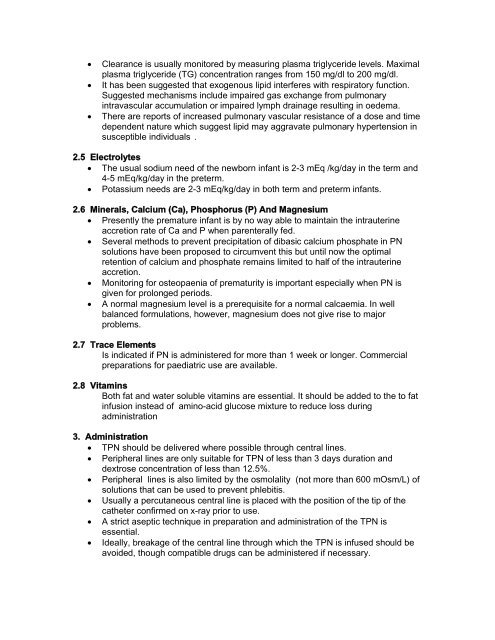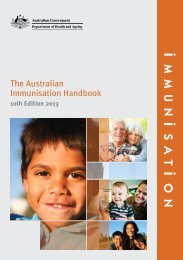Contents Chapter Topic Page Neonatology Respiratory Cardiology
Contents Chapter Topic Page Neonatology Respiratory Cardiology
Contents Chapter Topic Page Neonatology Respiratory Cardiology
You also want an ePaper? Increase the reach of your titles
YUMPU automatically turns print PDFs into web optimized ePapers that Google loves.
Clearance is usually monitored by measuring plasma triglyceride levels. Maximal<br />
plasma triglyceride (TG) concentration ranges from 150 mg/dl to 200 mg/dl.<br />
It has been suggested that exogenous lipid interferes with respiratory function.<br />
Suggested mechanisms include impaired gas exchange from pulmonary<br />
intravascular accumulation or impaired lymph drainage resulting in oedema.<br />
There are reports of increased pulmonary vascular resistance of a dose and time<br />
dependent nature which suggest lipid may aggravate pulmonary hypertension in<br />
susceptible individuals .<br />
2.5 Electrolytes<br />
The usual sodium need of the newborn infant is 2-3 mEq /kg/day in the term and<br />
4-5 mEq/kg/day in the preterm.<br />
Potassium needs are 2-3 mEq/kg/day in both term and preterm infants.<br />
2.6 Minerals, Calcium (Ca), Phosphorus (P) And Magnesium<br />
Presently the premature infant is by no way able to maintain the intrauterine<br />
accretion rate of Ca and P when parenterally fed.<br />
Several methods to prevent precipitation of dibasic calcium phosphate in PN<br />
solutions have been proposed to circumvent this but until now the optimal<br />
retention of calcium and phosphate remains limited to half of the intrauterine<br />
accretion.<br />
Monitoring for osteopaenia of prematurity is important especially when PN is<br />
given for prolonged periods.<br />
A normal magnesium level is a prerequisite for a normal calcaemia. In well<br />
balanced formulations, however, magnesium does not give rise to major<br />
problems.<br />
2.7 Trace Elements<br />
Is indicated if PN is administered for more than 1 week or longer. Commercial<br />
preparations for paediatric use are available.<br />
2.8 Vitamins<br />
Both fat and water soluble vitamins are essential. It should be added to the to fat<br />
infusion instead of amino-acid glucose mixture to reduce loss during<br />
administration<br />
3. Administration<br />
TPN should be delivered where possible through central lines.<br />
Peripheral lines are only suitable for TPN of less than 3 days duration and<br />
dextrose concentration of less than 12.5%.<br />
Peripheral lines is also limited by the osmolality (not more than 600 mOsm/L) of<br />
solutions that can be used to prevent phlebitis.<br />
Usually a percutaneous central line is placed with the position of the tip of the<br />
catheter confirmed on x-ray prior to use.<br />
A strict aseptic technique in preparation and administration of the TPN is<br />
essential.<br />
Ideally, breakage of the central line through which the TPN is infused should be<br />
avoided, though compatible drugs can be administered if necessary.
















